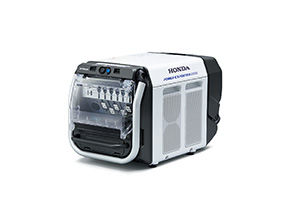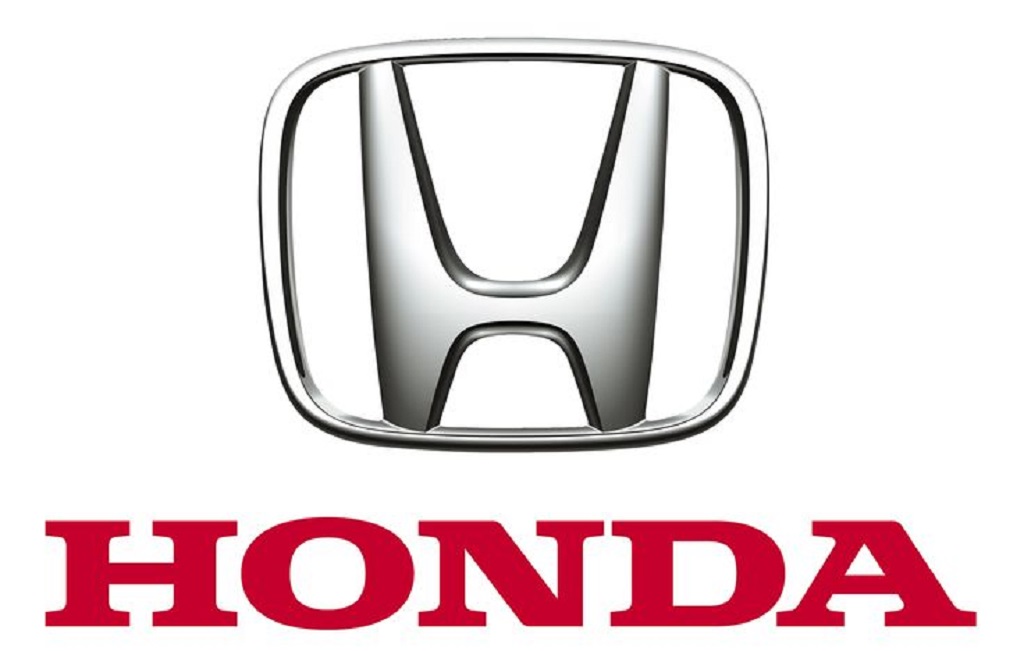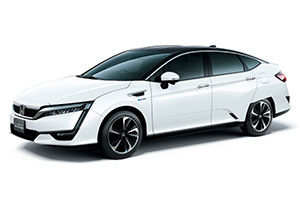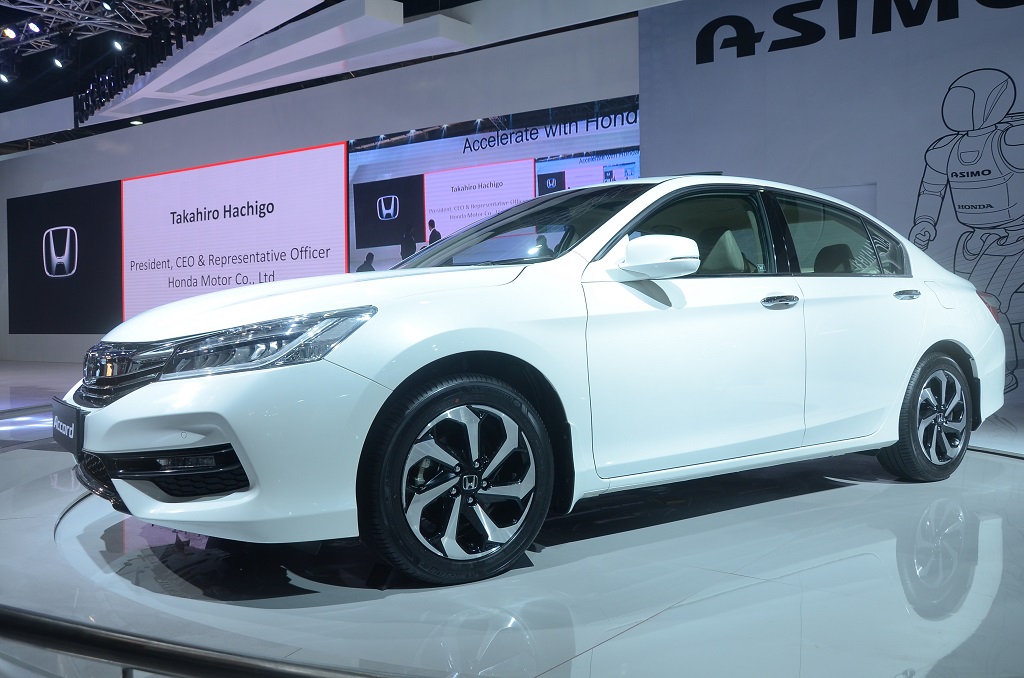TOKYO, Japan, March 10, 2016 – Honda Motor Co., Ltd. today began sales in Japan of its all-new fuel cell vehicle (FCV), the Clarity Fuel Cell.
Striving to realize full-fledged popularization of FCVs, Honda created Clarity Fuel Cell as an FCV featuring both a high level of practicality that represents the “universal value” of an automobile and “cutting-edge appeal” that is suitable for a vehicle that is at the forefront of the times. Clarity Fuel Cell is the world’s first*1 five-passenger sedan type FCV, realized by making the fuel cell powertrain more compact using original Honda technologies and fitting it entirely under the hood of the car.
Combined with the improved efficiency of the powertrain and a reduced energy requirement for driving, a 70 MPa high-pressure hydrogen storage tank installed to this vehicle provides a cruising range (for reference) of approximately 750 km*2, an increase of approximately 30% compared to the previous FCV model, to achieve the world’s top-class*3 cruising range among all zero emission vehicles. This increase in cruising range significantly improved the practicality of this FCV model as an everyday car which can accommodate all driving needs from everyday use to a long-distance driving trip. The hydrogen tank can be refilled in approximately three minutes*4, realizing ease of use equivalent to that of a gasoline-powered vehicle.
 Moreover, as part of its “cutting-edge appeal,” the Clarity Fuel Cell features an exterior design which combines dynamism and elegance as well as a quiet yet powerful and smooth driving feel which can be realized only by an electric vehicle equipped with a high-output motor with maximum output of 130 kW. In addition, in combination with a portable external power output device, the Power Exporter 9000, which also went on sale today, Clarity Fuel Cell can function as a “power source on wheels” that is capable of supplying approximately seven-days’ worth*5 of electricity for an average household.
Moreover, as part of its “cutting-edge appeal,” the Clarity Fuel Cell features an exterior design which combines dynamism and elegance as well as a quiet yet powerful and smooth driving feel which can be realized only by an electric vehicle equipped with a high-output motor with maximum output of 130 kW. In addition, in combination with a portable external power output device, the Power Exporter 9000, which also went on sale today, Clarity Fuel Cell can function as a “power source on wheels” that is capable of supplying approximately seven-days’ worth*5 of electricity for an average household.
For the first year of the Clarity Fuel Cell launch in Japan, Honda will focus on lease sales mainly to local government bodies or businesses Honda has already been working with for the popularization of FCVs. During this period, Honda will collect information about the in-market use of the Clarity Fuel Cell as well as the external power output device and gather diverse opinions and requests from customers and other relevant organizations, and then later begin sales to individual customers.
Honda will begin with small-volume production at the Production Supervisory Unit and Powertrain Production Supervisory Unit (located in Takanezawa-machi, Shioya-gun, Tochigi, Japan.), eventually expanding production volume. Moreover, Honda is planning to introduce the Clarity Fuel Cell to Europe and the U.S. before the end of 2016.
Honda was one of the first automakers to begin focusing attention on hydrogen as a possible solution for issues such as global warming and depletion of fossil fuels. Honda has been positioning the FCV, which emits only water, as the ultimate environmentally responsible vehicle and has taken a proactive approach to the research and development of FCVs since the late 1980s.
In 2002, the Honda FCX became the first fuel cell vehicle in the world to be certified by the U.S. Environmental Protection Agency (EPA) and the California Air Resources Board (CARB). With these certifications, Honda began sales of the Honda FCX in Japan and the U.S. In 2008, Honda became the first automaker to begin sales of the FCX Clarity, which featured an innovative sedan-type package and unprecedented driving experience. The all-new Clarity Fuel Cell was developed based on various data related to the ease of use and driving performance of these previous Honda FCVs.
With the goal to make a contribution to the forthcoming hydrogen energy society and to realize the joy and freedom of mobility and a sustainable society where people can enjoy life, Honda will continue taking on new challenges in the area of hydrogen technologies including the Smart Hydrogen Station, FCVs and external power output devices under the concept of “generate, use and get connected.”
<All-new Clarity Fuel Cell>
- Sales plan (in Japan, first year): Approximately 200 units
■Key specifications
| Number of occupants | 5 | ||
| Powertrain | Motor | Max. output | 130 kW/4,501-9,028 rpm [Max rpm: 13,000 rpm] |
| Max. torque | 300 N・m/0-3,500 rpm | ||
| Type | AC synchronous motor | ||
| Fuel cell stack | Max. output | 103 kW | |
| Type | Polymer electrolyte fuel cell (PEFC) | ||
| Drive battery | Type | Lithium-ion battery | |
| Fuel/tank | Fuel type | compressed hydrogen | |
| Tank capacity | 141 L (front: 24 L/ rear: 117 L) | ||
| Nominal pressure | 70 MPa | ||
| Vehicle size (length x width x height) | 4,915 mm x 1,875 mm x 1,480 mm | ||
| Vehicle weight | 1,890 kg | ||
| Price including consumption tax*6 (for reference) | 7,660,000 yen | ||
o Body color (total 3 colors)*7
– Premium Brilliant Garnet Metallic (Roof color: Black / Interior color: Platinum Gray)
– White Orchid Pearl (Roof color: Black / Interior color: Platinum Gray)
– Crystal Black Pearl (Interior color: Platinum Gray)
<Portable external power output device – Power Exporter 9000>
■Key specifications
| Rated output | 9 kVA |
| Output voltage/output frequency | AC100・200 V (single-phase three-wire system)
/50/60 Hz (frequency switching system) |
| Power conversion | Inverter |
| Weight | 50.8 kg |
| Overall length x width x height | 755 mm×387 mm×438 mm |
| Output terminal | 100 V×6 terminals /200 V x 1 terminal |
| Applicable standard | V2L Guideline DC 2.1 |
| Price including consumption tax*8
(for reference) |
1,180,000 yen |
*1 Among planned production models of sedan-type vehicles, Honda internal research as of February 2016
*2 Honda internal measurement in JC08 mode and after refueling the vehicle at a hydrogen station with charging pressure of 70 MPa under the standard conditions specified in the SAE standards (J2601) (e.g. Ambient temperature of 20 degrees Celsius/68 degrees Fahrenheit; Begin refueling into a high-pressure hydrogen tank with internal pressure of 10 MPa). The cruising range may vary when the vehicle is refueled at hydrogen station with different specifications, as the amount of hydrogen put in the tank will vary depending on the specifications of the hydrogen station. The cruising range is expected to be approximately 800 km when the vehicle is refueled under the same conditions using a hydrogen station that complies with new standards which will become effective after fiscal year ending on March 31, 2017. The cruising range also may vary significantly depending on conditions (ambient temperature, traffic congestion, etc.) and how the vehicle is driven (sudden starts, use of air- usage conditioning unit, etc.)
Range calculation based on Japanese JC08 drive cycle; anticipated U.S. EPA range rating to exceed 300 miles.
*3 Honda internal research as of February 2016
*4 Honda internal measurement using a hydrogen station with charging pressure of 70 MPa under the standard conditions specified in the SAE standards (J2601) (e.g. Ambient temperature of 20 degrees Celsius/68 degrees Fahrenheit; Begin refueling into a high-pressure hydrogen tank with internal pressure of 10 MPa). Time required for refueling may vary depending on charging pressure and ambient temperature.
*5 Calculated based on the average daily electricity consumption by an average household (Researched by the Federation of Electric Power Companies of Japan)
*6 This model is currently available exclusively for leasing. The lease price varies depending on lease terms and plans etc.
*7 There will be a 43,200 yen (including consumption tax) extra charge for White Orchid Pearl and 64,800 yen (including consumption tax) extra charge for Premium Brilliant Garnet Metallic.
*8 The price is a manufacturer’s suggested retail price (in Japan) and it is for reference only.


